Last Updated on July 27, 2022
Shallow and deep foundations are the two main types of foundations. The types of foundations are significant for any kind of construction for its stability and safety. Before selecting a foundation for a construction project, it’s very important to research its suitability. We are going to learn the types of foundations in this article under the shallow foundations and deep foundations categories.
What is Foundation in Civil Engineering?
The lowest member of a building or other structures that comes in direct contact with the ground is called the foundation, which properly distributes loads from the structure to the earth. Foundations can be categorized into two which are deep foundations and shallow foundations.
If the load from the structure and the weight of the foundation itself is transferred to soil strata which is present at a shallow depth below the foundation, we may say that the foundation is a type of shallow foundation. But if the load of the structure and the weight of the foundation itself is transferred to a soil strata that is present at a deep depth below structure, we may call it as a deep foundation. A deep foundation is necessary for tall buildings such as skyscrapers or structures to be built on weak soil. If the construction project is planned to have upper floors in the future, a deep foundation should be applied depending on the structure load and soil strength.
Types of Foundations in Construction
1. Shallow Types of Foundations
A shallow foundation, unlike a deep foundation, transfers structural loads to the ground that is very close to the surface, rather than a subsurface layer or a range of depths. Spread footings or open footings are another terms for shallow foundations. The term “open” refers to the fact that the foundations are built by first excavating all of the soil before the footing’s bottom, and then building the footing.
Shallow foundations are widely used because they are the most cost-effective and easy to construct foundation system. To design the foundation and prevent potential deterioration of the foundation performance, a detailed inspection of the foundation site and detailed information on the subsurface stratum is needed.
1. Individual Footings
Individual footings are one of the most basic and widely used types of foundations. When the load of the building is carried by columns, individual or isolated footings are used. Each column usually has its own footing. The footing is simply a reinforced concrete square or rectangular pad on which the column rests. The engineer can divide the overall load on the column by the soil’s safe bearing capacity to get an approximate estimate of the size of the footing. For instance, if a column has a vertical load of 20 tons and the soil’s safe bearing capacity is 10 tons/m2, the footing area can be 2m2. In reality, the engineer should consider a variety of other factors when preparing a footing construction design.
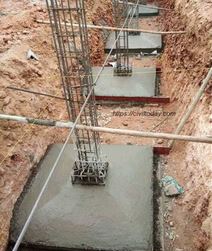
Individual footings should only be used where it is completely clear that there will be no varying settlements under the whole structure. Spread footings are not designed to support a wide range of loads. Mat (raft) footings or strip footings should be used in that situation.
2. Strip Foundation (Wall Footing)
Strip foundations are types of foundations that are composed of a continuous strip, generally of concrete, that goes through under of the center of the load bearing walls or closely-spaced rows of columns. This continuous strip works as a level basis for the wall and is wide enough to distribute the load on the foundations to an area of subsoil capable of bearing the load without excessive compaction. Concrete is the most commonly used foundation material today since it is easy to place, spread, and level in foundation trenches to provide a basis for walls, and it hardens to a sufficient compressive strength to support the load on foundations.
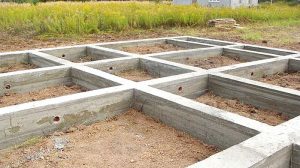
The bearing capacity of the subsoil and the load on the foundations determine the width of a concrete strip foundation. For the same load, the greater the bearing capacity of the subsoil, the thinner the base can be. These foundations are very basic types of foundations. For less suitable ground conditions, other alternatives such as raft foundations, which are simply a reinforced slab covering the whole building footprint, can be constructed.
3. Mat Foundation (Raft)
A raft or mat foundation is a big continuous rectangular or circular concrete slab that carries and distributes the entire load of the structural system over the entire area underneath the structure. It is one kind of shallow foundation that is effective for controlling differential settlement.
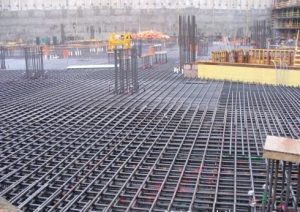
It’s a good choice for low-bearing-capacity soil, footings that cover about 65% of the structure, heavy structure loads, soft pockets or cavities in the soil to an uncertain degree, and easily compressible soil that reaches to a great depth.
In other words, a raft foundation is commonly used where the soil is not strong so it distributes the weight of the structure over the whole area of the structure rather than over smaller zones or at individual points. By doing this, it decreases soil stress.
4. Combined Footing
When two or more columns are close to each other and their foundations intersect, combined footings are built.
A footing or a foundation’s purpose is to transfer load from the structure to the underlying soil. The depth of the bearing strata, the soil condition, and the type of structure all affect the appropriate type of footing.
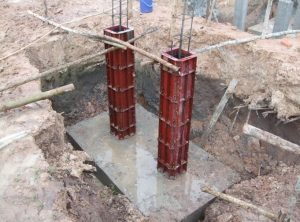
They are mostly made of reinforced concrete. The footing is assumed to be rigid and resting on homogeneous soil when designing footings. The maximum bending moment is used as the design value for the reinforced concrete footing, and it should be checked for maximum shear strength and bond, among other things. When the soil’s load-bearing capacity is limited, and individual footings need more area, a combined footing can be built.
5. Strap Foundation (Cantilever Footing)
A unique type of combined footing is strap footing or cantilever footing. Strap footings are made up of two independent bases linked together by a strap beam. The strap beam is supposed to be rigid and not to transfer any load to the ground at its bottom contact surface.
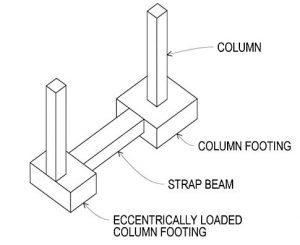
When the foundation of the column cannot be constructed beneath the column or when the column should not apply any pressure below, strap footing is required. In the event that footings cannot be constructed, it is then required to balance it using a cantilever arm that is supported by a nearby column.
2. Deep Types of Foundations
A deep foundation is the one that transfers loads to deep strata and is constructed deeper, and also one that provides lateral protection and resists to uplifting effect. These types of foundations transfer structural loads to more competent strata which is much under the ground level.
Due to poor soil bearing capacity at shallow depths, high design loads, and site constraints such as property lines, a deep foundation should be selected instead of a shallow foundation.
1. Pile Foundations
Pile foundations are types of foundations that are very deep. They are made up of long, slender columnar components that are mostly made of steel or reinforced concrete, but may also be made of wood. When the depth of a foundation is greater than the three times of its width, it is known as piled foundation.
Pile foundations are mostly used to transfer loads from structures to stronger, more dense, less compressible, and stiffer rock or soil at depth, thus raising the effective size of a foundation and resisting horizontal loads. They’re usually used for huge structures where the soil isn’t ideal for preventing undesired settlement
Driven Piles
Driven piles, also known as displacement piles, are a type of construction foundation that supports structures by transferring their load to layers of soil or rock with adequate bearing capacity and settlement characteristics. Driven piles are the most cost-effective deep foundation approach and are widely used to stabilize buildings, tanks, towers, walls, and bridges. Embankments, retaining walls, bulkheads, anchorage systems, and cofferdams are also examples of where they can be found.
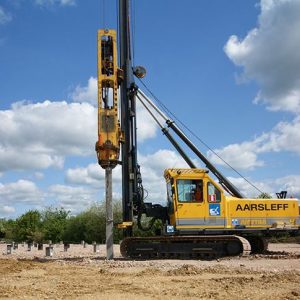
Precast piles (driven) are prefabricated components (mostly steel or concrete) that are driven into the ground using machinery by pressing, or vibration. This form of pile’s execution system is fast and independent of local conditions, resulting in good stability in soft soils.
Bored Piles
Bored piles are types of building foundations that support structures by transferring their load to layers of soil or rock with enough bearing capacity and settlement properties.
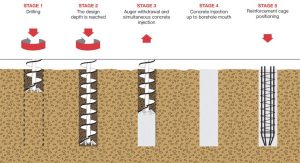
Bored piles are piles in which soil is removed to create a space for a reinforced concrete pile to be casted in place.
The soil is replaced by the pile, as opposed to driven piles where the soil are forced away from the ground by driving or screwing the driven pile.
2. Shaft Foundations
Drilling a cylindrical hole within a deep excavation and then filling it with concrete or another prefabricated load-bearing unit are the methods used to construct these types of foundations. They can be conveniently configured in terms of length and width. Drilled shafts can be built next to existing buildings and with low overhead, making them ideal for a variety of seismic retrofit projects. However, such environments, such as soils with boulders, soft soil, loose sand, and sand under water, can make its construction difficult.
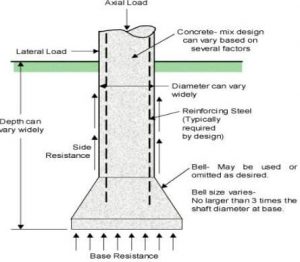
In other words, drilled shafts, also known as drilled piers or bored piles, are used to support structural systems that are subjected to high axial and lateral loads. They’re made by drilling cylindrical shafts into the ground, adding a reinforcement cage (if needed), and then filling them with concrete or other prefabricated load-bearing units.
3. Caissons
Caisson is a box-like design used in underwater construction or as a foundation in civil engineering. Its shape is generally rectangular or circular, and its diameter can reach tens of meters.
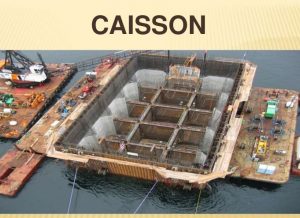
A box caisson is normally built at land, then launched, floated to place, and sunk into a previously prepared foundation, leaving the upper edge above water level.
It may be used as a shell for a column of a bridge, or for a seawall, breakwater and other related structures, and it can stay in place on the sea bottom forever.
Differences between Shallow and Deep Foundations
Usage
Deep foundations are only possible to be used where the bearing strength of the soils at the surface is insufficient and the load must be transferred to more competent strata at a significant depth. Bridges, skyscrapers, flyovers, dam systems, and off-shore structures are all built on deep foundations.
Different from deep foundations, shallow foundations or at grade foundations are used for common structures, low rise towers, concrete frame and wood frame buildings, and short span bridges.
Load Transferring
Deep foundations consider the side friction between the surface and the footing when transferring load.
As a result of side friction, the bearing ability of a deep foundation is improved, in addition to the normal bearing capacity of the sub soil strata.
Shallow foundations spread the structure’s load over a larger area thanks to the footing pad, and they rely on direct force transfer between the footing and near-surface soil/rock.
Cost
Deep foundations are much costlier than shallow foundations since deep foundations requires a significant volume of excavation and more amounts of materials like concrete and steel. Also, there should be necessary machineries to construct a deep foundation.
What are the main functions of foundation?
The main functions of foundations can be said that:
- The foundation gives a level surface for the construction works.
- The major purpose of the foundation is to evenly distribute the weight of the structure over a broader area in order to prevent the soil failure.
- It provides lateral stability to the structure by anchoring it to the ground. Because of the foundations, the building is more stable against overturning and sliding caused by horizontal forces such as an earthquake.
Types of foundations have been explained in this article. Hope you enjoyed it!

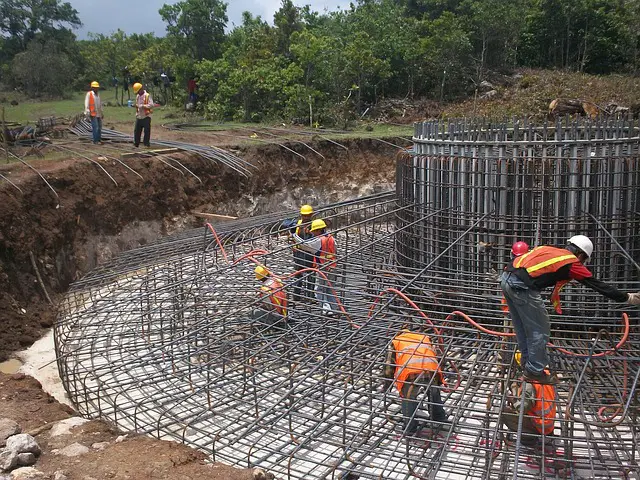
Pingback: Types of Forces and Stresses in Civil Eng. | techyildiz
Pingback: Construction Machinery and Equipment | techyildiz